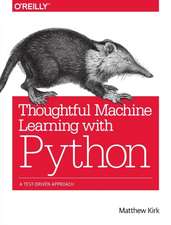Conceptual Modeling of Information Systems
Autor Antoni Olivéen Limba Engleză Paperback – 14 oct 2010
| Toate formatele și edițiile | Preț | Express |
|---|---|---|
| Paperback (1) | 341.63 lei 6-8 săpt. | |
| Springer Berlin, Heidelberg – 14 oct 2010 | 341.63 lei 6-8 săpt. | |
| Hardback (1) | 366.05 lei 6-8 săpt. | |
| Springer Berlin, Heidelberg – 28 aug 2007 | 366.05 lei 6-8 săpt. |
Preț: 341.63 lei
Preț vechi: 427.04 lei
-20% Nou
Puncte Express: 512
Preț estimativ în valută:
65.37€ • 69.90$ • 54.50£
65.37€ • 69.90$ • 54.50£
Carte tipărită la comandă
Livrare economică 18 aprilie-02 mai
Preluare comenzi: 021 569.72.76
Specificații
ISBN-13: 9783642072567
ISBN-10: 3642072569
Pagini: 484
Ilustrații: XXV, 455 p. 185 illus.
Dimensiuni: 155 x 235 x 30 mm
Greutate: 0.67 kg
Ediția:Softcover reprint of hardcover 1st ed. 2007
Editura: Springer Berlin, Heidelberg
Colecția Springer
Locul publicării:Berlin, Heidelberg, Germany
ISBN-10: 3642072569
Pagini: 484
Ilustrații: XXV, 455 p. 185 illus.
Dimensiuni: 155 x 235 x 30 mm
Greutate: 0.67 kg
Ediția:Softcover reprint of hardcover 1st ed. 2007
Editura: Springer Berlin, Heidelberg
Colecția Springer
Locul publicării:Berlin, Heidelberg, Germany
Public țintă
Professional/practitionerCuprins
Entity Types.- Relationship Types.- Cardinality Constraints.- Particular Kinds of Relationship Type.- Reification.- Generic Relationship Types.- Derived Types.- Integrity Constraints.- Taxonomies.- Domain Events.- Action Request Events.- State Transition Diagrams.- Statecharts.- Use Cases.- Case Study.- Metamodeling.- The MOF and XMI.
Recenzii
"The book is one of the most informative and comprehensive texts on conceptual modeling published to date. It is very appropriate for students of advanced level university courses in information systems, requirements engineering, or in data base design, as well as for qualified practitioners in the field." - Janis Bubenko, Royal Institute of Technology, Stockholm, Sweden
"Antoni Olivé has taken the time to create a book that is certain to become essential reading for students of conceptual modeling in information systems engineering." - Arne Solvberg, NTNU, Trondheim, Norway
"The text is advanced in notions and concepts, but is highly educational and informative, containing very interesting ideas explained and illustrated in detail. The most interesting aspect is that the text combines formalization with the fundamentals of information systems engineering under a holistic approach." - Lefteris Angelis, Computing Reviews, May 2008
"Antoni Olivé has taken the time to create a book that is certain to become essential reading for students of conceptual modeling in information systems engineering." - Arne Solvberg, NTNU, Trondheim, Norway
"The text is advanced in notions and concepts, but is highly educational and informative, containing very interesting ideas explained and illustrated in detail. The most interesting aspect is that the text combines formalization with the fundamentals of information systems engineering under a holistic approach." - Lefteris Angelis, Computing Reviews, May 2008
Notă biografică
Antoni Olivé is a professor of information systems at the Universitat Politècnica de Catalunya in Barcelona. He has worked in this field during over 25 years. His main interests have been, and are, conceptual modeling, requirements engineering, information systems design and databases.
Antoni Olivé was the recipient of the DKE-ER Elsevier award for his contribution to the Intl. Conf. on Conceptual Modeling (ER'2003) and was Program Co-chair of ER 2006 - the 25th International Conference on Conceptual Modeling.
Antoni Olivé was the recipient of the DKE-ER Elsevier award for his contribution to the Intl. Conf. on Conceptual Modeling (ER'2003) and was Program Co-chair of ER 2006 - the 25th International Conference on Conceptual Modeling.
Textul de pe ultima copertă
When designing an information system, conceptual modeling is the activity that elicits and describes the general knowledge the system needs to know. This description, called the conceptual schema, is necessary in order to develop an information system. Recently, many researchers and professionals share a vision in which the conceptual schema becomes the only important description to be created, as the system implementation will be automatically constructed from its schema – this is e.g. the basic idea behind OMG’s Model Driven Architecture.
Olivé’s textbook explains in detail the principles of conceptual modeling independently from particular methods and languages and shows how to apply them in real-world projects. He covers all aspects of the engineering process from structural modeling over behavioral modeling to meta-modeling, and completes the presentation with an extensive case study based on the osCommerce system, an online store-management software program freely available under the GNU General Public License. His presentation is based on well-known industry standards like UML and OCL as a particular conceptual modeling language, yet also delivers the basics of the formal logical language background.
Written for computer science students in classes on information systems modeling as well as for professionals feeling the need to formalize their experiences or to update their knowledge, Olivé delivers here a comprehensive treatment of all aspects of the modeling process. His book is complemented by lots of exercises and additional online teaching material.
Olivé’s textbook explains in detail the principles of conceptual modeling independently from particular methods and languages and shows how to apply them in real-world projects. He covers all aspects of the engineering process from structural modeling over behavioral modeling to meta-modeling, and completes the presentation with an extensive case study based on the osCommerce system, an online store-management software program freely available under the GNU General Public License. His presentation is based on well-known industry standards like UML and OCL as a particular conceptual modeling language, yet also delivers the basics of the formal logical language background.
Written for computer science students in classes on information systems modeling as well as for professionals feeling the need to formalize their experiences or to update their knowledge, Olivé delivers here a comprehensive treatment of all aspects of the modeling process. His book is complemented by lots of exercises and additional online teaching material.
Caracteristici
Explains the principles of conceptual modeling independently from particular methods and languages Presents the principles with the detail required to correctly apply them in real projects Explains the formal bases of conceptual schemas through the extensive use of intuitive ideas and examples Details the use of the standard UML/OCL as a particular conceptual modeling language Provides exercises for readers who want to practice and deepen their knowledge Gives lots of hints for further reading, including a huge list of bibliographical references for all the concepts presented in the book Includes supplementary material: sn.pub/extras


















